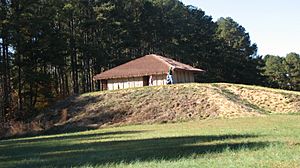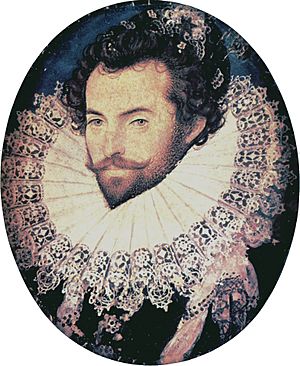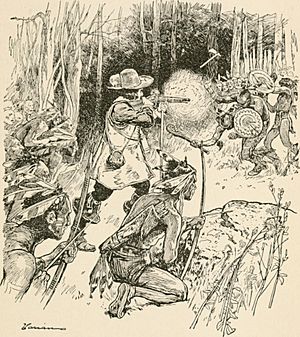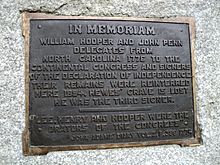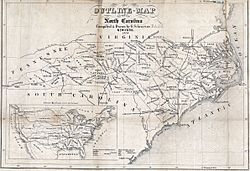History of North Carolina facts for kids
The history of North Carolina tells the story of the people and events that shaped the land now known as the U.S. state of North Carolina. This journey goes from ancient times all the way to today.
The oldest human settlements found in North Carolina are at the Hardaway Site. People lived there around 8000 BC. From about 1000 BC until Europeans arrived, it was called the Woodland period. During this time, the Mississippian culture of Native Americans grew, including parts of North Carolina.
When English colonists first arrived, they met Carolina Algonquian-speaking tribes along the coast. These included the Chowanoke, Roanoke, Pamlico, Machapunga, Coree, and Cape Fear Indians. In the state's interior, there were Iroquoian-speaking tribes like the Meherrin, Cherokee, and Tuscarora. Other tribes spoke Siouan languages, such as the Cheraw, Waxhaw, Saponi, Waccamaw, and Catawba.
The first English attempt to settle was the Roanoke Colony from 1584 to 1587. It's famously known as the "Lost Colony" and was sponsored by Sir Walter Raleigh. The Province of Carolina was created in 1629, becoming official in 1663. It later split in 1712, forming the Province of North Carolina. The state is named after King Charles I of England. It became a royal colony of the British Empire in 1729.
In 1776, North Carolina declared its independence from Great Britain. The Halifax Resolves, adopted on April 12, 1776, was the first official call for independence among the American Colonies during the American Revolution. On November 21, 1789, North Carolina became the 12th state to approve the United States Constitution.
From colonial times until the American Civil War, slavery was legal in North Carolina. Disagreements over slavery were a main cause of the Civil War. North Carolina left the Union on May 20, 1861. It was the last of eleven states to join the Confederate States. After the Civil War, North Carolina rejoined the Union on July 4, 1868. The Thirteenth Amendment to the United States Constitution was approved on December 6, 1865, ending legal slavery in the United States.
After the Reconstruction era, white Democrats took control of the state's government. In the 1890s, they passed Jim Crow laws. These laws made it hard for many poor white people to vote and stopped African Americans from voting. Jim Crow laws also forced racial segregation, meaning Black and white people were kept separate. These laws stayed in place until new federal laws were passed in the 1960s.
On December 17, 1903, Orville and Wilbur Wright successfully flew the world's first powered aircraft. This happened at Kill Devil Hills in the Outer Banks of North Carolina. In the late 1800s and early 1900s, North Carolina began to change from a farming economy to an industrial one. Many new jobs appeared across the state. Tobacco and textile factories started, especially in the Piedmont region. The furniture industry also became very important for North Carolina's economy for most of the 20th century.
The Great Depression in the 1930s hit North Carolina's economy hard. However, New Deal projects helped the state recover. After World War II, North Carolina's economy became more diverse. More industries helped the state grow in the following decades.
In the mid-20th century, Research Triangle Park was created in 1959. It is the largest research park in the United States, located near Raleigh, Durham, and Chapel Hill. During the Civil Rights Movement, the Greensboro sit-ins began. African American students led these protests, which helped end segregation at lunch counters in Greensboro. This movement spread to many other cities in America, helping to end racial segregation policies. In the 1960s, the Civil Rights Act of 1964 and Voting Rights Act of 1965 were passed. These laws gave African Americans a stronger voice in society and politics.
By the late 20th century, new industries became important for the state's economy. These included technology, pharmaceuticals, banking, food processing, and vehicle parts. This was a big change from the older industries like tobacco, textiles, and furniture. This shift happened because of global trade, the state's strong higher education system, national banking, changes in farming, and new companies moving to the state. In the 1990s, Charlotte became a major banking center. Through the late 20th century and into the 21st century, North Carolina's cities continued to grow. Many people moved to North Carolina from other parts of the U.S. and from other countries.
Contents
Ancient History of North Carolina
The earliest human settlements found in what is now North Carolina are at the Hardaway Site. This site is near the town of Badin in the south-central part of the state. Scientists believe this site is about 10,000 years old, dating back to around 8000 BC. They use methods like studying rock layers and the types of spear points found there.
Over the next 7,000 years, spear points slowly changed. This suggests that the culture of the people stayed similar for a long time. During this period, people likely lived as hunter-gatherers, moving to find food. Later, there is proof of settled agriculture, like growing plants and making pottery.
From 1000 BC until Europeans arrived, this time is called the "Woodland period." Permanent villages, based on farming, grew across the state. By about 800 AD, towns in the Piedmont region were protected by walls. This suggests that organized tribal warfare existed. An important place from this period is the Town Creek Indian Mound. This site was used from about 1100 to 1450 AD by the Pee Dee culture, part of the Mississippian culture.
First European Explorers
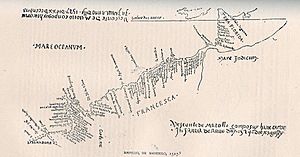
The first European to explore North Carolina was probably Giovanni da Verrazzano in 1524. He was an Italian explorer hired by French merchants. He was looking for a sea route to Asia. Verrazzano sailed west on January 1, 1524, on his ship La Dauphine.
His expedition landed at Cape Fear. Verrazzano described the land to the King of France. He said the seashore was covered with fine sand. He also saw beautiful fields and forests with many colorful trees.
Verrazzano continued north along the Outer Banks. He explored as he searched for a route to China. When he saw the Albemarle and Pamlico Sounds behind the Outer Banks, he thought they were the Pacific Ocean. His reports made people believe that Asia was much closer than it really was.
Just two years later, in 1526, a group of Spanish colonists arrived. They were led by Lucas Vázquez de Ayllón from Hispaniola. They landed at the mouth of a river they called "Rio Jordan," which might have been the Cape Fear River. The group included 500 men and women, their slaves, and horses. One of their ships was lost, and they faced illness and rebellion. Ayllón died in October 1526. The remaining 150 survivors left the colony and tried to return to Hispaniola. Later explorers found their remains along the coast.
Hernando de Soto explored west-central North Carolina during his expedition in 1539-1540. He may have first met Native Americans at Guaquilli, near modern Hickory. In 1567, Captain Juan Pardo led an expedition from Santa Elena. This was the capital of the Spanish colony in the Southeast. He went into North Carolina, mostly following De Soto's path.
Pardo's journey was meant to claim the area for Spain. He also wanted to make peace with and convert the Native Americans. He also hoped to find a new route to protect silver mines in Mexico. Pardo and his team made a winter camp at Joara, near Morganton. He renamed it Cuenca. They built Fort San Juan and left 30 men there. Pardo traveled further, building five more forts.
In 1567, Pardo's group also set up a mission called Salamanca in what is now Rowan County. Pardo returned to Santa Elena by a different route. After 18 months, in the spring of 1568, Native Americans killed all the soldiers and burned the six forts, including Fort San Juan. The Spanish never returned to claim the interior. This was the first European attempt to settle the interior of North Carolina.
British Colonization
The Lost Roanoke Colony
The first English attempt to build a colony in North America was the Roanoke Colony. It existed from 1584 to 1587 and is famous as the "Lost Colony." Sir Walter Raleigh supported this effort. The colony was set up on Roanoke Island in the Croatan Sound.
The first group of about 100 men was led by Ralph Lane. They built a fort and waited for supplies. While waiting, Lane and his men had conflicts with the local Croatan people. They even killed some in fights. However, the local people also taught the colonists how to survive, like how to build dugout canoes.
When supplies took too long to arrive, the colonists started to lose hope. After meeting Sir Francis Drake, they decided to go back to England with him. When the supply ships arrived a few days later, they found the colony empty. The ship's captain, Richard Grenville, left 15 men to guard the fort and wait for new colonists.
In 1587, a third ship arrived with 110 men, 17 women, and 9 children. Some of them had been part of the first group. This new group was led by John White. A pregnant woman in the group gave birth to Virginia Dare, the first English child born in North America. The colonists found the remains of the 15 men left behind. They were likely killed by the Croatan people who had been angered by Lane.
White had planned to move the colony to the Chesapeake Bay. But his pilot, Simon Fernandez, refused to go further. To avoid a mutiny, White agreed to resettle the old colony.
The war with Spain stopped any more contact between the colony and England until 1590. When an expedition finally arrived, they found no colonists. They only found an empty colony and the letters "CROATOAN" carved into a tree, and "CRO" carved into another. No one knows for sure what happened to the colony. Many historians believe the colonists died from hunger or illness. Others think they were taken in and became part of Native American tribes. Some Native Americans might have felt threatened by the colonists taking their land and food, leading to conflict.
Growing the North Carolina Colony
The Province of North Carolina grew differently from South Carolina from the start. The Spanish found it hard to settle North Carolina. It had a dangerous coastline, few good ports, and not many rivers for travel inland. In the 1650s and 1660s, settlers (mostly English) moved south from Virginia. These included runaway servants and fur trappers. They mainly settled in the Albemarle borderlands region.
In 1665, the King issued a second charter to clear up land questions. By 1689, the Carolina owners named a separate deputy-governor for the northern part of the colony. This part was north and east of Cape Fear. The colony was officially divided into North and South Carolina on December 7, 1710. The first colonial Governor of North Carolina was Edward Hyde, who served from 1711 to 1712. North Carolina became a royal colony in 1729.

Smallpox caused many deaths among Native Americans in the region. They had no natural protection against the disease, which was common in Europe. The 1738 epidemic was said to have killed half of the Cherokee people. Other tribes in the area also suffered greatly. Historians estimate there were about 5,000 settlers in 1700 and 11,000 in 1715.
Most voluntary settlers were British. Some brought Africans as workers. Most of these Africans were enslaved. Over the years, settlers bought more enslaved people to work on plantations in the lowlands. The number of Africans in the population quickly grew. A colony at New Bern was made up of Swiss and German settlers. In the late 1700s, more German immigrants moved south after entering Pennsylvania.
By 1712, the name "North Carolina" was commonly used. In 1728, the border between North Carolina and Virginia was surveyed. In 1730, North Carolina's population was 30,000. By 1729, the King bought out most of the original owners, making it a royal colony. John Carteret, 2nd Earl Granville refused to sell his part. In 1744, he received rights to the large Granville District, which was the northern half of North Carolina.
Bath, the oldest town in North Carolina, was the first capital from 1705 to 1722. Then Edenton took over. But the colony did not have permanent government buildings until they were built in the new capital, New Bern, in 1743. Raleigh became the capital of North Carolina in 1792.
More People Arrive
The colony grew quickly, from 100,000 people in 1752 to 200,000 in 1765. By 1760, enslaved Africans made up one-quarter of the population. They were mostly in the coastal areas.
In the late 1700s, many immigrants came to North Carolina from Virginia and Pennsylvania. The Scots-Irish (Protestants from Northern Ireland) were the largest immigrant group from the British Isles before the Revolution. English indentured servants also made up a large part of the English settlers. Before the American Revolution, North Carolina was the fastest-growing British colony in North America.
The small family farms in the Piedmont were very different from the large plantations along the coast. Wealthy planters in the coastal region used enslaved labor to grow tobacco and rice.
These differences in how eastern and western North Carolina were settled affected the state's politics, economy, and social life for a long time. The eastern Tidewater area was settled mostly by people from rural England and the Scottish Highlands. The western upcountry was settled mostly by Scots-Irish, English, and German Protestants. During the Revolutionary War, the English and Highland Scots in eastern North Carolina often stayed loyal to the British King. This was because they had strong business and personal ties to Great Britain. The English, Welsh, Scots-Irish, and German settlers in western North Carolina usually supported American independence from Britain.
The colony was mostly rural, with no big cities and very few towns. Local taverns offered many services. They provided drinks, beds for travelers, and meeting rooms for politicians and business people. These taverns helped mix different types of people, including locals and travelers.
The courthouse was usually the most important building in a county. Jails were often part of the courthouse or built separately. Some county governments built tobacco warehouses to help with their most important export crop.
Enslaved People in the Colony
In the early years, the difference between white indentured servants and African laborers was not always clear. Some Africans also arrived as indentured servants before more were brought as slaves. Some Africans were able to gain their freedom before slavery became a lifelong status based on race. Most of the free Black families in North Carolina in the 1790-1810 censuses came from relationships between free white women and enslaved or free African men in colonial Virginia. Because their mothers were free, their children were born free. These mixed-race families moved to the North Carolina frontier with their white neighbors.
As fewer indentured laborers came from Britain, the colony needed more workers and imported more enslaved people. North Carolina, like Virginia, increased its rules on slavery. Slavery became a racial system for people of African descent.
The colony's economy grew and became successful because of enslaved labor. This labor was first used to produce tobacco. The difficult lives of enslaved people and poor white people sometimes led them to escape, resist, or steal food to survive.
Political Tensions
In the late 1760s, tensions grew between farmers in the Piedmont and planters on the coast. This led to the Regulator movement. Money was scarce, and many inland farmers could not pay their taxes. They were angry when their property was taken as a result. Local sheriffs sometimes kept taxes for themselves or charged people twice. Governor William Tryon spent a lot of money building a new governor's mansion, Tryon Palace, in New Bern. This made the farmers even angrier.
Because the western areas had too few representatives in the colonial legislature, the farmers could not get their problems fixed through laws. The frustrated farmers took up arms and closed the court in Hillsborough, North Carolina. Governor Tryon sent troops to the region and defeated the Regulators at the Battle of Alamance in May 1771.
A New Nation: North Carolina's Role
The American Revolution
The demand for independence came from local groups called "Committees of Safety." The First Continental Congress had asked for these groups to be formed in 1774. By 1775, they became like local governments, slowly replacing the King's authority. They managed the economy, politics, and local militias. Many local disagreements were also handled under these groups. After December 1776, they came under the control of a stronger central group, the Council of Safety.
In the spring of 1776, North Carolinians met in their fourth Provincial Congress. They wrote the Halifax Resolves. These resolutions gave the state's representatives to the Second Continental Congress the power to agree to a declaration of independence from Great Britain. In July 1776, North Carolina became part of the new nation, the United States of America.
In 1775, the Patriots easily removed the Royal governor and stopped the Loyalists. In November 1776, elected representatives met in Halifax to write a new state constitution. This constitution stayed in effect until 1835. One important Loyalist was John Legett, a rich planter in Bladen County. He led one of the few Loyalist groups in the South. After the war, Colonel Legett and some of his men moved to Nova Scotia. The British gave them free land as payment for their losses. Most Loyalists stayed in North Carolina and became citizens of the new nation.
Local militia groups were important in the guerrilla war of 1780-81. Soldiers who joined George Washington's Continental Army fought in many battles across the country.
State officials struggled with a weak tax system. They used impressment to take food and supplies for the war, paying farmers with promises of future payment. To get soldiers, state officials tried a draft law. Both of these policies caused much unhappiness and weakened support for the new nation. The state's large German population, mostly in the central counties, tried to stay neutral. The Moravians were pacifists because of their strong religious beliefs. Other German groups were also neutral. All peace groups paid triple taxes instead of serving in the military.
The British paid their soldiers and Loyalist forces on time. But American soldiers went months without pay. They had worn-out uniforms and little food. Later, the state tried to make up for this. After 1780, soldiers received cash, a slave "or the value thereof," clothing, food, and land. After 1782, they received 640 to 1,200 acres depending on their rank. Since the paper money lost value quickly, state officials valued payment in gold and silver.
Battles of 1780-81
After 1780, the British tried to get Loyalists to fight, believing there were enough of them to make a difference. This led to fierce guerrilla warfare between Patriots and Loyalists. Often, people used this chance to settle personal arguments. A major American victory happened at King's Mountain on the North Carolina–South Carolina border. On October 7, 1780, 1,000 mountain men from western North Carolina defeated 1,000 Loyalist and British troops led by Major Patrick Ferguson. This victory largely ended British efforts to recruit more Loyalists.
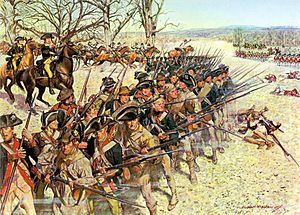
The path to American victory at Yorktown went through North Carolina. As the British army moved north toward Virginia, the Southern Division of the Continental Army and local militia prepared to meet them. General Daniel Morgan defeated the British under Banastre Tarleton at the Battle of Cowpens on January 17, 1781. Then, the southern commander Nathanael Greene led British Lord Charles Cornwallis across North Carolina. This pulled Cornwallis away from his supply base in Charleston, South Carolina. This campaign is known as "The Race to the Dan."
Generals Greene and Cornwallis finally met at the Battle of Guilford Courthouse in present-day Greensboro on March 15, 1781. Even though the British troops held the battlefield, they suffered heavy losses. Cornwallis's plan had failed to hold his positions in South Carolina and Georgia, and he had not taken control of North Carolina. Greene used a more flexible approach that helped the Americans. Greene's defensive actions allowed his forces to later take the attack from Cornwallis and reclaim the Carolinas. The weakened Cornwallis headed to the Virginia coast to be rescued by the Royal Navy. A French fleet stopped the British Navy. Cornwallis, surrounded by American and French forces, surrendered to George Washington. This effectively ended the fighting.
By 1786, North Carolina's population had grown to 350,000.
Early Years of the Republic
The United States Constitution, written in 1787, caused debate in North Carolina. Meetings in Hillsboro in July 1788 first voted to reject it. They had anti-federalist reasons. They were convinced to change their minds partly by the efforts of James Iredell and William Davies. Also, the idea of a Bill of Rights helped. Meanwhile, people in the wealthy northeastern part of the state, who supported the Constitution, threatened to leave the state if it didn't agree. A second meeting was held in Fayetteville in November 1789. On November 21, North Carolina became the 12th state to approve the U.S. Constitution.
North Carolina adopted a new state constitution in 1835. One big change was that the governor would now be directly elected for a two-year term. Before 1835, the legislature elected the governor for one year. North Carolina's current capitol building was finished in 1840.
Transportation Improvements
In the mid-1800s, a 129-mile (208 km) wooden plank road was built. It connected Fayetteville in the east to Bethania (northwest of Winston-Salem). This "farmer's railroad" connected the state's rural and commercial areas.
On October 25, 1836, construction began on the Wilmington and Raleigh Railroad. This railroad was meant to connect the port city of Wilmington with the state capital of Raleigh. In 1849, the North Carolina Railroad was created by law. It extended the railroad west to Greensboro, High Point, and Charlotte. During the Civil War, the Wilmington-to-Raleigh part of the railroad was very important for the Confederate war effort. Supplies shipped into Wilmington were moved by rail through Raleigh to the Confederate capital of Richmond, Virginia.
Life in Rural Areas
During the period before the Civil War, North Carolina was a very rural state, even for the South. In 1860, only one North Carolina town, the port city of Wilmington, had more than 10,000 people. Raleigh, the state capital, had just over 5,000 residents.
Most white families were "yeoman farmers." They owned their own small farms and sometimes had one or two enslaved people. They mostly worked to build up their farms and feed their families. They sold a small amount of extra crops to pay taxes and buy what they needed.
Plantations, Slavery, and Free Black People
After the Revolution, Quakers and Mennonites worked to convince slaveholders to free their enslaved people. Some slaveholders were inspired by these efforts and the ideals of the Revolution to free their slaves. The number of free Black people in the state increased noticeably in the first few decades after the Revolution. Most of the free Black families found in North Carolina in the 1790-1810 censuses were descendants of African Americans who became free in colonial Virginia. Their mothers were free, so their children were born free. These mixed-race families moved to the frontier of North Carolina with their white neighbors.
Free Black people also gathered in the eastern coastal plain. This was especially true in port cities like Wilmington and New Bern. There, they could find various jobs and had more freedom in the cities. However, rules against them increased starting in the 1820s. Free Black people were not allowed to move between counties. More rules in 1830 under a quarantine act stopped free Black sailors on visiting ships from contacting any Black people in the state. In 1835, free Black people lost the right to vote. This happened after white fears grew following Nat Turner's Slave Rebellion in 1831. By 1860, there were 30,463 free people of color living in the state, but they could not vote.
Most of North Carolina's slave owners and large plantations were in the eastern part of the state. While its plantation system was smaller than in Virginia, Georgia, or South Carolina, many planters were in the counties around Wilmington and Edenton. They were also in the Piedmont around Raleigh, Charlotte, and Durham. Planters who owned large estates had significant political and economic power before the Civil War. They often put their interests above those of the "yeoman" farmers in the western part of the state, who generally did not own slaves.
Slavery was less concentrated in North Carolina than in some Southern states. However, according to the 1860 census, more than 330,000 people, or 33% of the population of 992,622, were enslaved African Americans. They lived and worked mainly on plantations in the eastern Tidewater and the upland areas of the Piedmont.
From Civil War to 1900
The Civil War
In 1860, North Carolina was a slave state. About one-third of its population of 992,622 were enslaved African Americans. This was a smaller percentage than in many other Southern states. Also, the state had just over 30,000 free Black people. There were relatively few large plantations or old aristocratic families. North Carolina was slow to leave the Union when it became clear that Republican Abraham Lincoln had won the presidential election. But after the attack on Fort Sumter in April 1861, and Lincoln's call for troops, the pro-Union feeling in the state almost disappeared. North Carolina then joined the Confederacy.
North Carolina saw few major battles. However, it provided at least 125,000 troops to the Confederacy. This was more than any other state. About 40,000 of those troops never returned home, dying from disease, battle wounds, and hunger. North Carolina also supplied about 15,000 Union troops. Confederate soldiers from North Carolina fought in almost all the major battles of the Army of Northern Virginia, the Confederacy's most famous army.
The largest battle fought in North Carolina was at Bentonville. This was a last effort by Confederate General Joseph Johnston to slow Union General William Tecumseh Sherman's advance through the Carolinas in the spring of 1865. In April 1865, after losing the Battle of Morrisville, Johnston surrendered to Sherman at Bennett Place, in what is now Durham, North Carolina. This was the second-to-last major Confederate Army to surrender. North Carolina's port city of Wilmington was the last major Confederate port for blockade runners. It fell in the spring of 1865 after the nearby Second Battle of Fort Fisher.
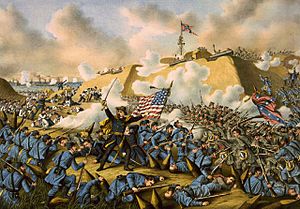
Governor Zebulon Baird Vance, elected in 1862, tried to keep the state independent from Confederate President Jefferson Davis.
The Union's naval blockade of Southern ports and problems with the Confederate transportation system greatly affected North Carolina residents. The high inflation during the war years also caused hardship. In the spring of 1863, there were food riots in North Carolina as city dwellers struggled to buy food. On the other hand, blockade runners brought wealth to several port cities until the Union Navy stopped them in 1864-65.
Even after leaving the Union, some North Carolinians refused to support the Confederacy. This was especially true for non-slave-owning farmers in the state's mountains and western Piedmont region. Some of these farmers stayed neutral during the war. Others secretly supported the Union cause. About 2,000 white North Carolinians from western North Carolina joined the Union Army and fought for the North. Also, Black men quickly volunteered to fill two Union regiments formed in the coastal areas of the state that were controlled by Union forces in 1862 and 1863.
Reconstruction Era
During Reconstruction, many African American leaders emerged. Some had been free before the war. Others had escaped to the North and returned. Some were educated people from the North who wanted to help after the war. Generally, most African Americans and about one-third of white people in the state could not read or write in the early postwar years.
Some white northerners moved to North Carolina to work and invest. While many in the state disliked "carpetbaggers" (Northerners who moved South after the war), only 18 of the 133 people at the constitutional convention were Northern carpetbaggers. Fifteen were African American. North Carolina was allowed back into the Union in 1868 after approving a new state constitution. This constitution included rules to create public education for the first time. It also banned slavery and allowed all men to vote. It also set up public welfare institutions for the first time, such as orphanages and a prison. The legislature approved the Fourteenth Amendment to the U.S. Constitution.
In 1870, the Democratic Party regained power in the state. Governor William W. Holden had tried to use his power to fight the growing violence of the Ku Klux Klan. The Klan used violence to stop Black and Republican voting. Conservatives accused Holden of being the head of the Union League, believing in racial equality, and being corrupt. But when the legislature voted to remove him from office, they only charged him with using troops to stop the Klan's violence. Holden was removed from office on December 20, 1870. His trial began on January 30, 1871, and lasted almost three months. On March 22, the North Carolina Senate found Holden guilty and ordered him removed.
After the national Ku Klux Klan Act of 1871 was passed to reduce violence in the South, the U.S. Attorney General, Amos T. Akerman, strongly prosecuted Klan members in North Carolina. In the late 1870s, there was new violence in the Piedmont area. White people tried to stop Black people from voting in elections. Starting in 1875, the Red Shirts, a paramilitary group, openly worked for the Democrats to stop Black voting.
After Reconstruction: Losing the Right to Vote
Like in other Southern states, after white Democrats regained power, they worked to bring back white supremacy in politics and society. Paramilitary groups like the Red Shirts openly tried to break up Black political meetings. They intimidated leaders and directly challenged voters in campaigns and elections, especially in the Piedmont area. Sometimes they physically attacked Black voters and community leaders.
Despite this, in the 1880s, Black officeholders were at their highest number in local offices. They were elected from districts where Black people were the majority. White Democrats regained power at the state level.
After the Civil War, racial politics led to efforts to divide groups. To regain power, Democrats supported a plan in 1885 to create separate school districts for "Croatan Indians." This was to gain their support. These mixed-race families, who claimed Native American heritage, had been classified as free people of color before the war. They did not want their children to go to public school classes with former slaves. After voting with the Republicans, they switched to the Democrats. (Later, this group changed their name several times and were given limited recognition as Indians by the U.S. Congress as Lumbee in 1956.)
In 1894, after years of farming problems, a group of Republicans and Populists (an interracial coalition) won most seats in the state legislature. They elected Republican Daniel L. Russell as governor. That year, North Carolina's 2nd congressional district elected George Henry White, an educated African American lawyer. He was the third Black representative from North Carolina to Congress since the Civil War.
White Democrats worked to break up this biracial group and reduce voting by Black people and poor white people. In 1896, North Carolina passed a law that made voter registration more difficult. This reduced the number of Black people on voter registration lists.
In 1898, in an election with violence, fraud, and intimidation of Black voters by Red Shirts, white Democrats regained control of the state legislature. Two days after the election, a small group of white people in Wilmington carried out a plan. They took over the city government even though the mayor and most of the city council were white. This group led 1,500 white people against the Black newspaper and neighborhood. This event is known as the Wilmington Insurrection of 1898. The mob and other white people killed up to 90 Black people. The group forced Republican officeholders, including the white mayor and mostly white aldermen, to resign and leave town. They replaced them with their own people and elected Alfred M. Waddell as mayor. This was a famous takeover in United States history.
In 1899, the Democrat-controlled state legislature approved a new constitution. It included a voting amendment with requirements like poll taxes, literacy tests, and longer residency. These rules stopped most Black people and many poor white people from voting. Illiterate white people were protected by a grandfather clause. This meant if their father or grandfather had voted in 1860 (when all voters were white), they did not have to pass the literacy test of 1899. This grandfather clause excluded all Black people, as free Black people had lost the right to vote in 1835. The U.S. Supreme Court ruled in 1915 that such grandfather clauses were unconstitutional. Every voter had to pay the poll tax until the state ended it in 1920.
Congressman White, an African American Republican, said after this constitution passed, "I cannot live in North Carolina and be a man and be treated as a man." He had been re-elected in 1898. But the next year, he announced he would not seek a third term, saying he would leave the state. He moved his law practice to Washington, DC, and later to Philadelphia, Pennsylvania, where he started a commercial bank.
By 1904, Black voter turnout in North Carolina had been greatly reduced. Estimates at the time said that 75,000 Black male citizens lost the right to vote. In 1900, Black people made up about 33% of the state's total population (630,207 citizens). But they could not elect representatives.
With control of the legislature, white Democrats passed Jim Crow laws. These laws created racial segregation in public places and transportation. African Americans worked for more than 60 years to regain their full right to vote and other constitutional rights. Without the ability to vote, they were excluded from juries and lost all chances at local offices. These included sheriffs, justices of the peace, jurors, county commissioners, and school board members. These were important government roles around the start of the 20th century. Stopping Black votes and bringing back white supremacy also hid the fact that there had been a successful Black middle class in the state. The Republicans were no longer strong in state politics, though they had some support in the mountain districts.
North Carolina in the 20th Century
| Historical population | |||
|---|---|---|---|
| Census | Pop. | %± | |
| 1790 | 393,751 | — | |
| 1800 | 478,103 | 21.4% | |
| 1810 | 556,526 | 16.4% | |
| 1820 | 638,829 | 14.8% | |
| 1830 | 737,987 | 15.5% | |
| 1840 | 753,419 | 2.1% | |
| 1850 | 869,039 | 15.3% | |
| 1860 | 992,622 | 14.2% | |
| 1870 | 1,071,361 | 7.9% | |
| 1880 | 1,399,750 | 30.7% | |
| 1890 | 1,617,949 | 15.6% | |
| 1900 | 1,893,810 | 17.1% | |
| 1910 | 2,206,287 | 16.5% | |
| 1920 | 2,559,123 | 16.0% | |
| 1930 | 3,170,276 | 23.9% | |
| 1940 | 3,571,623 | 12.7% | |
| 1950 | 4,061,929 | 13.7% | |
| 1960 | 4,556,155 | 12.2% | |
| 1970 | 5,082,059 | 11.5% | |
| 1980 | 5,881,766 | 15.7% | |
| 1990 | 6,628,637 | 12.7% | |
| 2000 | 8,049,313 | 21.4% | |
| 2010 | 9,535,471 | 18.5% | |
| 2013 (est.) | 9,848,060 | 3.3% | |
| Source: 1910–2010 | |||
Because of segregation, losing the right to vote in 1899, and farming problems in the early 1900s, many African Americans left North Carolina. Hundreds of thousands also left other Southern states for the North and Midwest. This was part of the Great Migration. In its first wave (1910-1940), 1.5 million African Americans left the South. They went to cities like Washington, Baltimore, and Philadelphia, and sometimes further north to industrial cities where there were jobs.
On December 17, 1903, the Wright brothers made the first successful airplane flight at Kitty Hawk, North Carolina. In the early 20th century, North Carolina started big projects for education and road building. These aimed to improve the state's economy. Governor Charles Brantley Aycock launched the education project in 1901. It is said that North Carolina built one school per day while Aycock was governor. Also, in the 1920s and 1930s, the Julius Rosenwald Fund helped North Carolina. It gave matching funds to local communities to build thousands of schools for African Americans in rural areas across the South. Black parents organized to raise money and donated land and labor to build better schools for their children.
World War I and Changes
By 1917-1919, because African Americans could not vote and the state had only one main political party, North Carolina Democrats held powerful positions in Congress. They had important committee chairmanships in both the Senate and the House. White Southerners controlled many votes in Congress because they had stopped Black people from voting but had not lost any congressional representation. With the delegation controlled by Democrats, they worked together as a party. Their members gained seniority by being re-elected for many years. In the early 1900s, the Congressional delegation helped get several major U.S. military bases built in North Carolina, like Fort Bragg. President Woodrow Wilson, a Democrat from the South, was very popular during World War I and was generally supported by North Carolina's representatives.
During the war, the old shipbuilding industry was revived with large government contracts. Nine new shipyards opened in North Carolina to build ships. Thousands of workers rushed to these high-paying jobs. However, there was a shortage of skilled mechanics and a housing shortage. Even though unions were weak, labor problems and inexperienced managers caused delays. The shipyards closed at the end of the war.
The North Carolina Woman's Committee was set up as a state agency during the war. It was led by Laura Holmes Reilly of Charlotte. Inspired by the Progressive Movement, it registered women for volunteer services. It promoted more food production and less wasteful cooking. It also helped maintain social services, supported soldiers, improved public health and schools, and encouraged Black women to join its programs. Members helped deal with the terrible Spanish flu epidemic that hit worldwide in late 1918, causing many deaths. The committee was generally successful in reaching middle-class white and Black women. However, it faced challenges from male lawmakers, limited money, and less interest from women on farms and in working-class areas.
The state's road-building project began in the 1920s, after cars became popular.
The Great Depression and World War II
Farmers in North Carolina were badly hurt in the early years of the Great Depression. But they greatly benefited from the New Deal programs. The tobacco program, for example, guaranteed a steady and relatively high income for farmers. The cotton program raised the prices farmers received for their crops. The textile industry in the Piedmont region continued to attract cotton mills moving from the North. In the North, unions had been successful in getting better wages and conditions.
Good times largely returned during World War II. North Carolina supplied the armed forces with more textiles than any other state. Remote mountain areas joined the national economy and experienced prosperity for the first time. Hundreds of thousands of young men and some young women from North Carolina joined the military.
A political scientist named V. O. Key studied North Carolina's political culture in the late 1940s. He concluded that it was special in the South for its "progressive outlook and action." This was especially true in industrial development, commitment to public education, and a moderate approach to segregation. This was different from the strict racism found in the Deep South.
Education and Economic Growth
North Carolina invested a lot in its higher education system. It became known for its excellent universities. Three major institutions form the state's Research Triangle: the University of North Carolina at Chapel Hill (started in 1789 and greatly expanded from the 1930s), North Carolina State University, and Duke University (restarted in 1924).
The public elementary and high schools were not as well-known. In the 1960s, Governor Terry Sanford, who was moderate on racial issues, called for more spending on schools. But Sanford's program used taxes that affected workers more. In the 1970s, Governor James B. Hunt Jr., another racial moderate, supported education reform.
Reformers have stressed how important education is for the state's modernization and economic growth. They have also actively worked to attract new businesses. They offered special tax deals and improved infrastructure to companies from other states and countries. In the late 20th century, Charlotte became the nation's second-largest banking center, after New York.
The Civil Rights Movement
In 1931, the Negro Voters League was formed in Raleigh. Its goal was to push for voter registration. The city had educated and politically aware Black middle class citizens. By 1946, the League had registered 7,000 Black voters. This was a big achievement in the segregated South. North Carolina had largely stopped Black people from voting with its new constitution in 1899. This excluded them from the political system and strengthened white supremacy and Jim Crow.
The work to end segregation and enforce civil rights for African Americans continued across the state. In the first half of the 20th century, other African Americans moved away. This was part of the Great Migration. They moved from rural areas to northern and midwestern cities where there were factory jobs.
During World War II, Durham's Black newspaper, The Carolina Times, edited by Louis Austin, led the "Double V" strategy. This strategy encouraged Black people to fight for victory abroad against the Germans and Japanese. At the same time, they fought for victory at home against white supremacy and racial oppression. Activists demanded an end to racial inequality in education, politics, economics, and the armed forces.
In 1960, almost 25% of North Carolina residents were African American. This was 1,114,907 citizens who had been living without their full constitutional rights. African American college students began the sit-in at the Woolworth's lunch counter in Greensboro on February 1, 1960. This started a wave of similar sit-ins across the American South. The Greensboro sit-in continued on and off for several months. Finally, on July 25, African Americans were allowed to eat at Woolworth's. Integration of public places followed.
Through continued activism across the South and raising awareness nationwide, African Americans' moral leadership led to the passage of federal laws. These were the Civil Rights Act of 1964 and the Voting Rights Act of 1965 under President Lyndon B. Johnson. Across the state, African Americans began to fully participate in political life. In October 1973, Clarence Lightner was elected mayor of Raleigh. He made history as the first popularly elected mayor of the city. He was also the first African American to be elected mayor, and the first African American to be elected mayor in a white-majority city in the South. In 1992, the state elected its first African American congressman since George Henry White in 1898.
In 1979, North Carolina ended its state eugenics program. Since 1929, the state Eugenics Board had decided that thousands of people were "feeble minded." They made sure these people could not have children. The victims of this program were mostly minorities and poor people.
Recent Changes
In 1971, North Carolina approved its third state constitution. A 1997 amendment to this constitution gave the governor veto power over most laws. Most state residents began to support Republican national candidates in elections starting in 1968 with Richard M. Nixon.
Over the last 25 years, North Carolina's population has grown as its economy has expanded. This is especially true in finance and knowledge-based industries. People have moved to North Carolina from the North and Midwest. The number of workers in farming has dropped sharply because of machines. The textile industry has steadily declined because of global trade and jobs moving out of the country. Most of the job and population growth has happened in the cities of the Piedmont, like Charlotte, Raleigh-Durham, and Greensboro.
Images for kids
-
Artists conception of Town Creek Indian Mound during the late Town Creek-early Leak phases circa 1350 CE
-
Map of the coast of Virginia and North Carolina, drawn 1585–86 by Theodor de Bry, based on map by John White of the Roanoke Colony
-
1751 Fry-Jefferson map depicting the Virginia Colony and surrounding provinces, including the Great Wagon Road spanning from Pennsylvania to North Carolina
-
Reconstructed royal governor's mansion, Tryon Palace, in New Bern
-
1st Maryland Regiment holding the line at the Battle of Guilford Courthouse, 1781
-
William Woods Holden, a Unionist who served as the 38th and 40th Governor of North Carolina, and during the Reconstruction era
-
First successful flight of the Wright Flyer, near Kitty Hawk, 1903
-
Map of Research Triangle, with points representing NC State University, Duke University, and University of North Carolina at Chapel Hill


